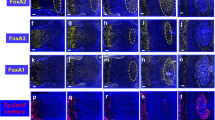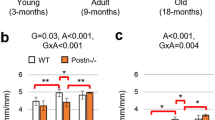Abstract
The twy (tiptoe-walking-Yoshimura) mouse is a mutant having a systemic hyperostotic disposition. Osseous overgrowth occurs not only in the spine but also in other skeletal tissues including the calvarium. To clarify the pathogenic mechanism of hyperostotic lesions, bone cells were cultured from twy and normal mouse calvariae to analyze the growth and extracellular matrix production in both genotypes. The cultures of osteoblast-enriched cells were established by explant procedure. The cells of the twy genotype showed accelerated growth and elevated levels of collagen synthetic activity compared to normal cells. However, no significant difference was noted in noncollagenous protein synthesis between the two genotypes. Furthermore, the mutant cells maintained these abnormal functions during several cell passagesin vitro. These results indicated that an unusual phenotype of twy bone cells distinguished by accelerated growth and selective stimulation of collagen production may play a major role in the development of hyperostotic lesions in twy micein vivo.
Similar content being viewed by others
References
Hosoda Y, Yoshimura Y and Higaki S: A new breed of mouse showing multiple osteochondral lesions - twy mouse. Ryumachi 21 (suppl): 157–164, 1981
Yamazaki M, Moriya H, Goto S et al.: Increased type XI collagen expression in the spinal hyperostotic mouse (TWY/TWY). Calcif Tissue Int 48: 182–189, 1991
Kobayashi Y, Goto S, Hyakutake S et al.: The process of parietal bone loss of TWY mouse. J Jpn Soc Bone Morphom 2: 85–88, 1992 (in Japanese)
Jee WSS: The skeletal tissue. In: Histology, Cell and Tissue (L. Weiss ed.), The MacMillan Press, London. p. 200, 1983
Robey PG and Termine JD: Human bone cellsin vitro. Calcif. Tissue Int 37: 453–460, 1985.
Hata R, Ninomiya Y, Sano J et al.: Activation of collagen synthesis in primary culture of rat liver parenchmal cells (hepatocytes). J Cell Physiol 122: 333–342, 1985
Hata R, Ninomiya Y, Nagai Y et al.: Biosynthesis of interstitial types of collagen by albumin-producing rat liver parenchymal cell (Hepatocyte) clones in culture. Biochemistry 19: 169–176, 1980
Hata R, Hori H, Nagai Y et al.: Selective inhibition of type I collagen synthesis in osteoblastic cells by epidermal growth factor. Endocrinology 115: 867–876, 1984
Osdoby P and Caplan AI: First bone formation in the developing chick limb. Dev Biol 86: 147–156, 1981
Hassel TM, Page RC, Narayanan AS et al.: Diphenylhydantoin (Dilantin) gingival hyperplasia: Drud-induced abnormality of connective tissue. Proc Nat Acad Sci USA 73: 2909–2912, 1976
LeRoy EC: Connective tissue synthesis by scleroderma skin fibroblasts in cell culture. J Exp Med 135: 1351–1362, 1972
Centrella M, Carthy TL and Canalis E: Transforming growth factor β is a bifunctional regulator of replication and collagen synthesis in osteoblast-enriched cell cultures from fetal rat bone. J Biol Chem 262: 2869–2874, 1987
Seydin SM, Sagarini PR, Rosen DM et al.: Cartilage-inducing factor-B is a unique protein structurally and functionally related to transforming growth factor-β. J Biol Chem 262: 1946–1949, 1987
Robey PG, Young MF, Flanders KC et al.: Osteoblasts synthesize and respond to transforming growth factor β (TGF-β) in vitro. J Cell Biol 105: 457–463, 1987
Noda M and Camilliere JJ:In vivo stimutation of bone formation by transforming growth factor-β. Endocrinology 124: 2991–2994, 1989
Author information
Authors and Affiliations
About this article
Cite this article
Yamazaki, M., Goto, S., Kobayashi, Y. et al. Bone cells from spinal hyperostotic mouse (twy/twy) maintain elevated levels of collagen productionin vitro . J Bone Miner Metab 12, 57–63 (1994). https://doi.org/10.1007/BF02383410
Issue Date:
DOI: https://doi.org/10.1007/BF02383410




